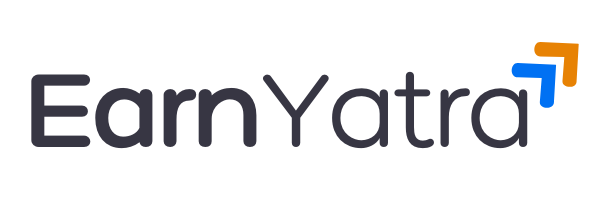Keeping servers in good condition is a critical task for every network administrator since it guarantees seamless operation, peak performance, and guaranteed uptime on every system. From resource management to detection and fixing of potential problems before they become huge ones, the proper server monitoring software is the key to guaranteeing a secure and efficient IT infrastructure.
We have compiled this list for you to introduce you the 10 Best Server Monitoring Tools which are a must for all IT professionals or business owners who want to have a solid and stable web presence.
What are Server Monitoring Tools?
Server monitoring software is specialized applications installed by network administrators to monitor and maintain the performance and status of servers. These software collect statistics from servers, including CPU utilization, memory usage, disk space, and network traffic, to verify everything operates normally. Through ongoing monitoring of these statistics, administrators can immediately detect problems such as bottlenecks, hardware problems, or suspicious activity that will affect operations.
One of the most significant advantages of server monitoring tools is their real-time alert feature. If a server is about to overheat, reaches capacity, or goes down, the tools inform the administrators at once. This ensures immediate response and reduces the possibility of extended downtime. Additionally, most monitoring devices have historical data and trend reporting, which enables admins to plan ahead for future needs and organize upgrades before something happens.
These software tools also provide integration with third-party systems, making it easy to manage all aspects of a network from a single platform. Whether it is ensuring high availability, preventing data loss, or optimizing server performance, server monitoring tools play a key role in achieving a stable and efficient IT environment for companies of any size.
What are the characteristics of Best Server Monitoring Tools?
- Real-Time Monitoring: Server monitoring tools offer real-time information about server performance, monitoring the key parameters like CPU usage, memory usage, disk usage, and network usage. This allows the administrator to identify and rectify the performance problems in real time.
- Alert Notifications: These features initiate advance notifications by email, SMS, or other means when performance thresholds are exceeded, enabling quick action on likely problems before they impact end-users.
- Resource Usage Reports: Detailed reporting of server resource usage over time helps identify trends, optimize resource usage, and predict future growth.
- Application and Service Monitoring: Server monitoring software also tracks applications and services within servers to confirm that they are running at peak performance and with zero interruptions.
- Uptime and Downtime Monitoring: Server monitoring software keeps an eye on server uptime and downtime, and it provides the administrators with accurate insight into the server reliability and availability.
- Interoperability with other products: All server monitoring products interoperate seamlessly with IT management products as an attempt to offer centralized IT infrastructure management.
- Security Warnings: They enable administrators to impose necessary patches whenever they identify any malicious activity, such as unauthorized access or possible security risk.
- Flexible Dashboards: Easy-to-use dashboards with real-time insight allow administrators to focus on the metrics that matter most to them.
- Scaling: Server monitoring software can scale with an organization so that more servers and devices can be added as easily as the network expands.
- Log Analysis: It analyzes server logs to inform useful information regarding bottlenecks in performance, failures, and intrusions so that it can help troubleshoot and identify the root cause.
- Automation Features: Recurring operations like rebooting services and log cleaning save time of administrators for redundant tasks and assist in allocating efforts to core activities.
- By employing all these utilities, server monitoring software allow administrators to provide an established, reliable, and good-performing information technology infrastructure.
Who Needs The Best Server Monitoring Software?
Server monitoring software is a vital solution for IT infrastructure-based companies that provide services and run their operations. Server monitoring software is utilized predominantly by the following:
- Large corporations : Large corporations have tens of thousands of servers in various data centers, and it is impossible to monitor manually. Server monitoring software assists large corporations in maintaining uptime, maintain performance, and troubleshoot problems real-time.
- Managed service providers (MSPs): MSPs that host IT infrastructure for several customers require good server monitoring software in order to uphold their service level agreements. These kinds of software are used by MSPs to monitor client servers proactively before their clients are affected. Server monitoring also helps MSPs manage resources across different client environments more efficiently.
- Cloud providers : Cloud providers like Infrastructure as a Service (IaaS) and Platform as a Service (PaaS) depend greatly on server monitoring software to make their services stable and efficient. These solutions are essential for monitoring virtual machines, containerized environments, and other cloud resources, while also factoring in considerations like cloud CPU pricing to manage cost-performance balance effectively.
- DevOps teams : Server monitoring software is embedded in CI/CD pipelines within DevOps-practicing companies. DevOps teams use these tools to monitor how deployments are impacting server performance in real-time and prevent new code from releasing with a deleterious effect on the production environment.
- IT security divisions : The software can be used to detect attempted unauthorized access, unusual traffic levels, or other anomalies indicating that a breach in data has taken place. The tools are deployed by IT security units to detect server integrity and act fast upon a suspected attack.
- Research and academic institutions : High-computing capacity academic institutions and research organizations, including high-performance computing clusters, utilize server monitoring tools for infrastructure management and optimization.
Top 10 Best Server Monitoring Tools
1. Nagios

Nagios is a server monitoring tool with open-source technology that monitors network services, host resources, and network devices thoroughly to provide maximum availability and performance for business-critical IT applications.
It offers real-time monitoring, alerting, and reporting, which helps administrators to detect and resolve problems in time, minimize downtime, and business operations can be carried out without interruptions.
Nagios is very flexible and scalable and provides the benefit of many plugins and integrations. This renders it suitable for heterogeneous environments as well as for high-level monitoring requirements.
Features:
- Monitoring of server performance and availability in real-time.
- Extensive plugin library for any type of monitoring operation.
- Customization of alerting and reporting.
Pros:
- Large user base with numerous plugins.
- Extremely customizable to meet specific monitoring needs.
- Free and open-source.
Cons:
- Difficult initial setup and configuration process.
- Dated user interface compared to newer products.
Pricing:
- Free for Nagios Core.
- Nagios XI, the enterprise product, offers more features with prices beginning at $4,490 for 100 nodes.
2. Zabbix

Zabbix is a free, open-source server monitoring tool that provides end-to-end monitoring and analysis of various network services, servers, and devices, identifying problems ahead of time and resolving them.
It supports strong features such as real-time monitoring, alerting, and visualization to assist administrators in having high availability and performance of their IT infrastructure by using comprehensive metrics and trends.
Zabbix is highly customizable and supports a wide range of platforms. It supports integration with numerous third-party solutions and can grow from small configurations to massive enterprise networks.
Features:
- Agent-based and agentless monitoring features.
- Data visualization and reporting features that are rich in data.
- Monitors IoT devices and cloud environments.
Pros:
- No licensing charges as it is open-source.
- Very much customizable.
- Very good support for many platforms and technologies.
Cons:
- Strenuous learning curve for new users.
- Needed huge resources for large deployments.
Pricing:
- Open source and free.
- Commercial support offered at different prices based on needs.
3. SolarWinds Server & Application Monitor (SAM)
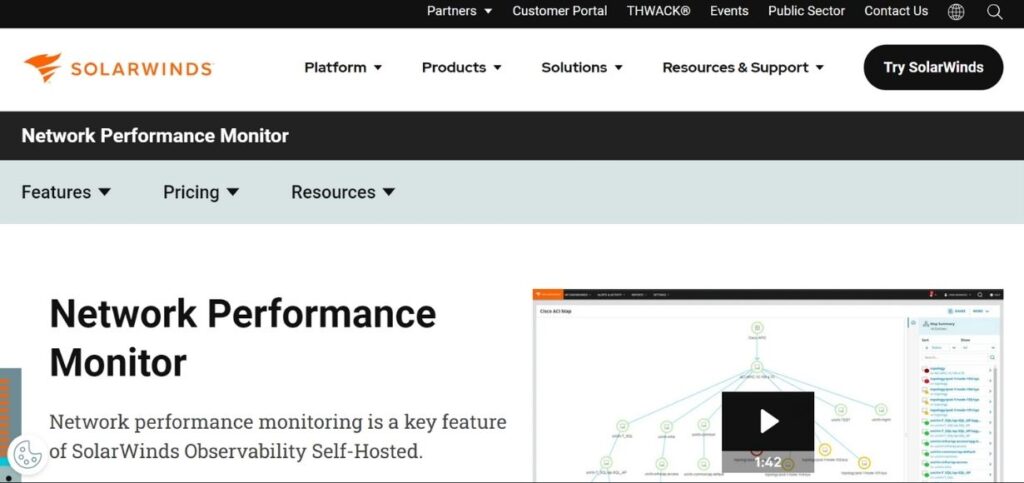
SolarWinds Server & Application Monitor (SAM) is an all-in-one monitoring solution for advanced IT infrastructure that provides visibility into server, application, and infrastructure performance and availability.
Its agentless approach relies on native industry-standard protocols like SNMP, WMI, and PowerShell to collect data from applications and servers. SAM offers real-time monitoring with immediate visibility into performance metrics and status presented in easy-to-understand dashboards, graphs, and charts.
It also facilitates capacity planning through analyzing trends in historical data and offering predictive analysis. SAM facilitates automation and remediation by being integrated with other SolarWinds products, enabling administrators to run scripts or take actions to fix problems remotely.
Features:
- Auto-discovery of application and server dependencies.
- Real-time performance monitoring with alert customization.
- Advanced reporting and dashboard functions.
Pros:
- Easy-to-use interface with robust visualization features.
- Diverse monitoring capabilities for varied environments.
- Robust vendor support and documentation.
Cons:
- Very high licensing fees.
- Resource-hungry, particularly in large-scale deployments.
Pricing:
- Begins at $1,886 with a free trial option.
4. PRTG Network Monitor

PRTG Network Monitor is a comprehensive network monitoring tool that provides you with insight and management of your network’s infrastructure, devices, and applications.
It gathers real-time performance data and statistics through monitoring technologies like SNMP, WMI, NetFlow, and packet sniffing.
It provides a set of predefined sensors for monitoring various properties of network devices and applications, such as bandwidth usage, CPU and memory utilization, response times, and service uptime.
The scalability of PRTG enables the administrators to monitor small to large networks and has remote monitoring capability so that they can monitor scattered configurations.
Features:
- Pre-configured sensors for all types of monitoring tasks.
- Visualization of real-time data through interactive dashboards.
- Configurable alerting and notification system.
Pros:
- Easy to install and use, even for beginners.
- Scalable licensing model by the number of sensors.
- Outstanding support and detailed documentation.
Cons:
- Pricing can grow very quickly with the number of sensors.
- Fewer advanced features than some of its competitors.
Pricing:
- Free version offered.
- 30-day free trial that converts to freeware edition afterwards.
- Paid plans begin at $2,149 for up to 50 devices.
5. Datadog
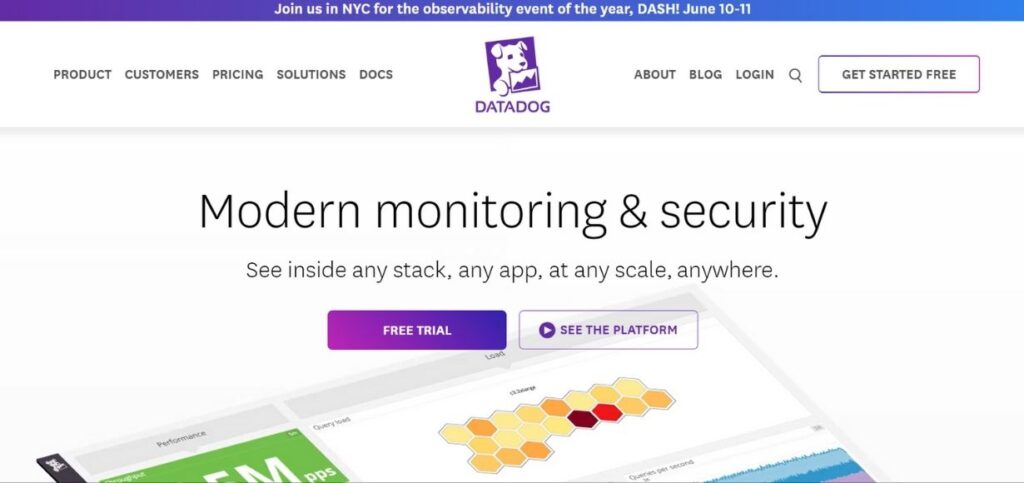
Datadog is a robust server monitoring solution aimed at delivering end-to-end visibility into the health and performance of servers and applications.
It does this by installing agents on servers, gathering a broad set of metrics, storing and processing the data in a distributed backend system, and offering a centralized web interface for viewing and analyzing the metrics, configuring alerts, and taking advantage of advanced monitoring features.
With its easy-to-use interface and robust visualization capabilities, Datadog allows users to build personalized dashboards, configure automated alerts, and work together seamlessly across teams, improving visibility and operational effectiveness throughout the entire IT ecosystem.
Features:
- Smooth integration with DevOps tools and cloud vendors.
- Anomaly detection and AI-based alerts.
- Strong reporting and dashboard support.
Pros:
- Excellent cloud infrastructure support.
- Easy integration with the existing infrastructure.
- Extremely scalable and flexible.
Cons:
- Too costly for large environments or high-scale monitoring needs.
- Complex configurations learning curve.
Pricing:
- Free plan available with one day metric retention and up to five hosts.
- Paid plans have a free trial.
- Pro plan from $15 per host per month.
- Business plan begins at $23 per host monthly.
6. New Relic
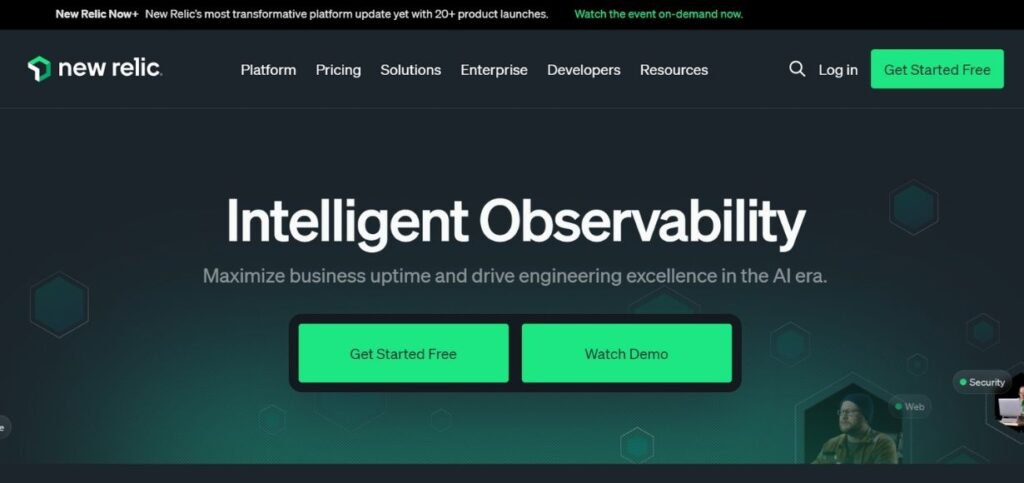
New Relic Server Monitoring Tool is an in-time monitoring tool that is meant to monitor servers’ health and performance. It uses a light-weight agent on every server to gather stats like CPU usage, memory usage, disk I/O, network utilization, and process activity.
It also includes alerting, storage and analysis of history, analysis of trends, capacity planning, as well as server-related issue troubleshooting.
It ensures optimization of the monitoring and server infrastructure administration for optimal performance and minimal downtime.
Features:
- End-to-end visibility with granular server metrics.
- Real-time alerting and incident response.
- Integration with many DevOps and cloud platforms.
Pros:
- Extremely intuitive interface with solid analytics.
- Good support for microservices and distributed systems.
- Enterprise-grade scalability for any size organization.
Cons:
- Very costly for full-featured usage.
- Increased complexity with larger deployments.
Pricing:
- Free tier with 100 GB of free data ingest per month and unlimited free basic users.
- Paid plans begin at $49 per user per month and $0.35 per GB over 100 GB.
7. ManageEngine

ManageEngine server monitoring software is a one-box solution to monitor server performance and availability of IT infrastructure.
It functions by installing agents inside the servers to retrieve real-time statistics and details regarding CPU utilization, memory usage, disk space, network usage, etc. Installation is made easy with pre-installed monitoring templates for most server platforms and applications.
With its intuitive ease-of-use interface and cutting-edge features, ManageEngine server management software streamlines server management, enhances performance, and ensures your critical server infrastructure is always up and running.
Features:
- Real-time monitoring with automatic discovery.
- Detailed reporting and historical analysis.
- Support for cloud servers and virtualized environments.
Pros:
- Global monitoring abilities under a single umbrella.
- High level of vendor support and community backing.
- Value for money for medium and large business enterprises.
Cons:
- Very crowded interface for newcomers.
- Complex features require additional license purchases.
Pricing:
- Basic plan offered free.
- Premium plans starting from $245 for Standard Edition
- $345 for Professional Edition
- $11,545 for Enterprise Edition.
8. Site24x7
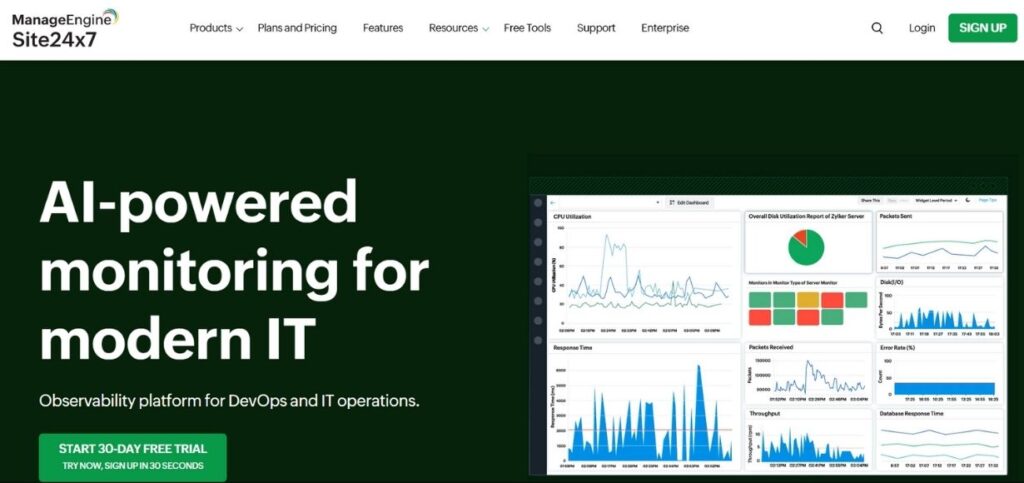
Site24x7 is a cloud IT infrastructure server monitoring tool available in customized packages for server monitoring, network monitoring, application performance monitoring, multi-cloud monitoring, and website end-user monitoring.
Since Site24x7 is a cloud monitoring tool, you don’t install it on your site and no need to ramp up your current server space needs and can monitor remotely from the site and on cloud servers.
The server monitoring functionality provides monitoring of Windows, Linux, FreeBSD, and Mac OS platforms. It also supports monitoring virtualization platforms such as Microsoft Hyper-V, VMware, and Docker containers.
Features:
- Unified monitoring of servers, applications, and network devices.
- Real-time alerts with customizable thresholds.
- Cloud-based, no installation necessary.
Pros:
- Simple to deploy and utilize.
- Handles a broad variety of monitoring needs in one platform.
- Scalable for businesses of any size.
Cons:
- Cost can become excessive with intensive monitoring.
- Limited on-premises features.
Pricing:
- 30-day free trial.
- Paid plans begin at $42 per month.
9. Icinga
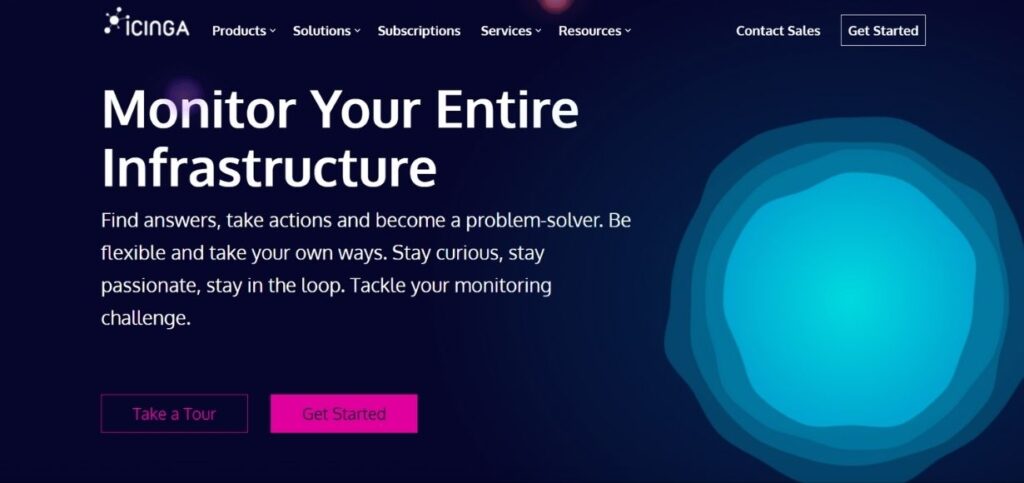
Icinga is a well-known server monitoring software that monitors the performance of the server and the network administrator receives immediate alert regarding the current status. Icinga is a derivative of Nagios hence it has a shared functionality which will assist in server monitoring.
Icinga is an open-source monitoring system that monitors the availability of servers, network resources, and applications. It is a Nagios fork and provides greater flexibility and scalability.
Features:
- Multi-level monitoring architecture which supports REST API.
- Alerts and custom dashboards.
- Horizontal scaling for large and complex configurations.
Pros:
- Rich plugin ecosystem and community.
- Very flexible and customizable.
- Licensing no cost.
Cons:
- Challenging to learn on first install.
- Must be configured manually for more advanced features.
Pricing:
- Free and open-source.
- Commercial support options with custom pricing.
10. Sensu Go
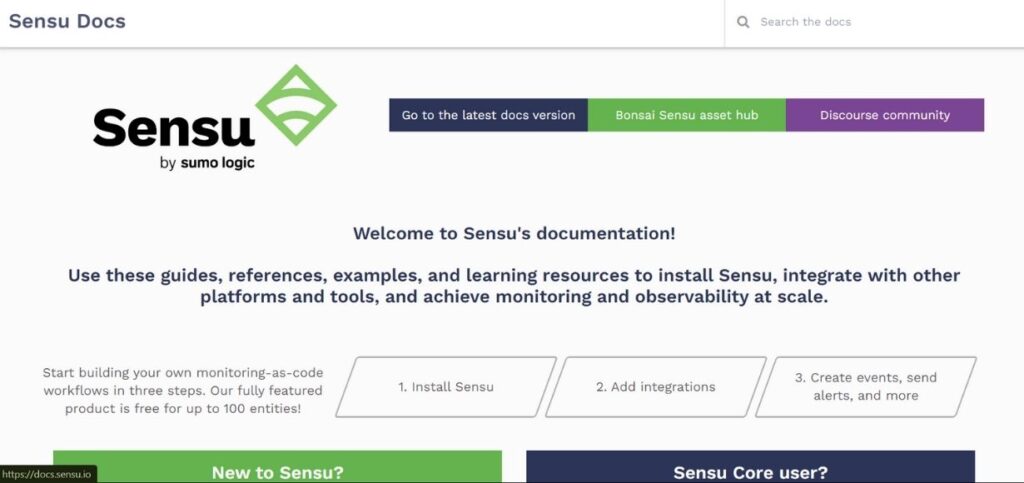
Sensu Go is an open-source server monitoring tool with high configurability and flexibility. It monitors servers, services, and applications on different environments.
Sensu Go is most famously known for its observability pipeline functionality where users can capture, filter, and manipulate data. It’s built for contemporary infrastructure, such as cloud-native environments.
Features:
- Monitoring as code for infrastructure-as-code environments.
- Native support for dynamic and ephemeral infrastructure.
- Integration with mainstream DevOps tools
Pros:
- Very flexible and adaptable.
- Good support for cloud-native and containerized environments.
- Free and open-source base version.
Cons:
- Difficulty in setup and configuration.
- Needs knowledge of infrastructure as code concepts.
Pricing:
- Sensu Go is free for 100 nodes or less.
- The Pro Plan is $3 per node per month
Conclusion
In managing a network, it is important to have the best server monitoring tool to guarantee stability, performance, and rapid issue resolution. The tools being discussed, both free and paid, provide various features that could be appropriate for various requirements. Picking the best monitoring solution depends on your budget, network size, and other requirements such as real-time alerts or history analysis. Spending money in a robust monitoring solution makes you optimize your IT infrastructure, reduce downtime, and have reliable systems for your organization.
